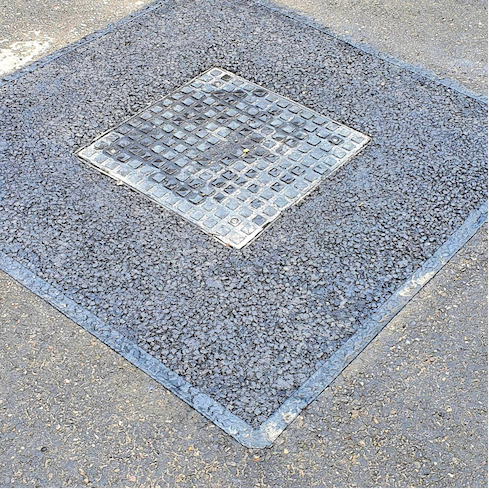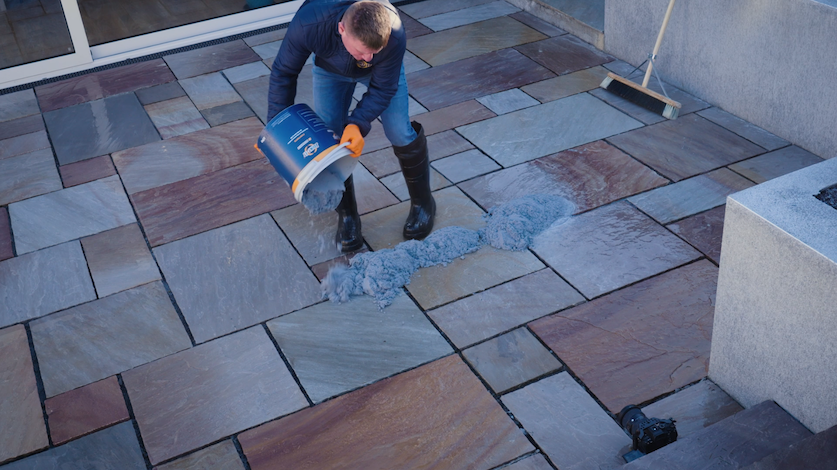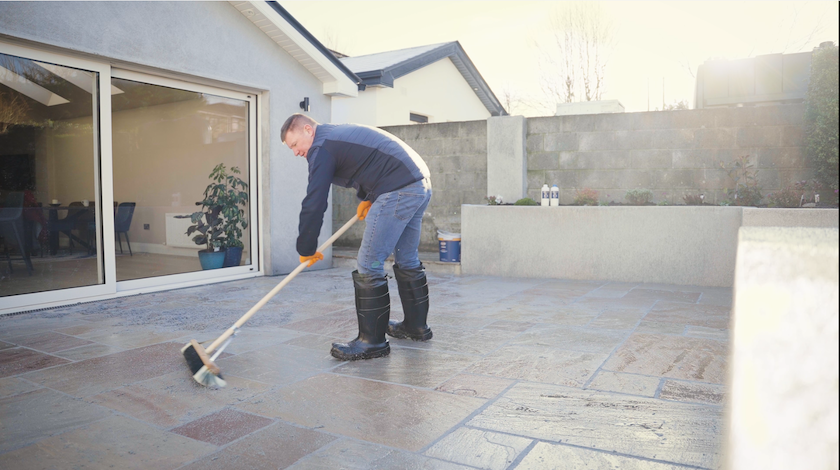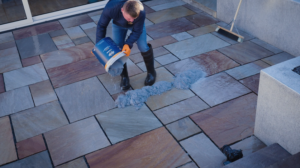As a hardscape surfacing specialist and manager of the UK’s biggest civils and Tarmac social media group, Dan Cloke is no stranger to repairing potholes for major civil projects, large-scale commercial clients and highways authorities. We have a chat with Dan to discover his trade secrets for permanent pothole repairs and the best approach for dealing with the headaches that regularly face contractors in the surfacing trade.
First off, about Dan and his hardscape expertise
Dan Cloke is a surfacing specialist with near-on two decades of experience in installing major civil projects, bitmac surfacing and asphaltic materials, and hardscapes such as porcelain and natural stone. He has written guidance on landscaping for professional installation, predominantly advising on hard landscaping materials.
You may have come across Dan before in the professional fields of civil work, Tarmac and paving, particularly from the popular social media groups he has set-up and continues to manage and moderate. These include the Civils Groundwork & Tarmac Talk Group on Facebook with over 10,000 members.
Without further ado, let’s find out Dan’s tricks of the trade and his top pothole repair tips for contractors.

What is the best way of preventing pothole failures?
Water ingress is the main cause of pothole failures. Dan explains that this can always be avoided by following a step-by-step process when repairing potholes.
“Poor back-fill of materials in the pothole and poor compaction are the two major contributing factors that create the conditions for a pothole to fail”, he says.
“A wise old boy once told me, ‘What’s on top is only as good as what’s underneath’. If the groundwork (excuse the pun) is poor, then the job is just not going to last.”
For any surfacing newbies, best practice in pothole repair involves cutting vertical edges around the hole and removing all debris so the filler will more effectively stick to the edges. A cold-jointing spray on the vertical edges is then used to strongly adhere the mix. Layers of fill are then added, with each of them fully compacted to prevent water ingress. The final layer should be tamped down until flush with the adjacent surfaces.
“Ultimately, time (or the lack of) is the main reason why poor installation happens in the first place,” adds Dan. “Patchwork can be tedious, especially when there are many potholes to patch-up on a road.
“I do think that the conduct and approach of a company or individual is vital for creating a long-lasting pothole repair. Although it can take time, following the recommended steps for pothole repair is worth it in the long-run – for a job that lasts and that helps gain repeat business from satisfied clients.”
What is your advice for permanent pothole repairs?
Dan shares, “Getting the filler right is an essential aspect. I am a firm believer in trying to use a hot mix (hot-lay tarmac), whenever possible.
“Obviously sourcing a hot, batched mix is not always feasible, so cold-lay packs of tarmac are superb for quick repairs. There are ‘off-the-shelf’ hot-lay tarmacs available now too, such as Enviro Mastic, that do the job well and don’t even need a mechanical plate compactor as it can be easily compressed using a hand tamp.”
Avoid cutting corners
Dan goes on to explain about the process of repairing potholes.
“Clean joints, where the verticals are shelved to support the joint, are also a must. It’s crucial to cut around each reinstatement area with a circular saw to create those vertical edges and remove all debris and standing water.”
“We all know it in the industry,” he adds, “but there are occasions when some decide to cut corners to save on time and labour.
“Ultracrete SCJ spray is a great vertical joint emulsion as it helps to bond the face of the reinstatement.”
Follow industry specs
Dan also talks about the HAUC specifications. The Highway Authorities and Utilities Committee is a representative body that works with local highways authorities and utilities companies to make improvements to how works are managed across the street and road network.
“When applicable, always follow HAUC specifications for the local authority you’re working,” he says.
“HAUC specs might cover the requirements for using a like-for-like product to ensure the best aesthetic finish. Polymer modified mixes with a low penetration grade will always be a good choice for reinstatement as they are less susceptible to water ingress.
“Good compaction is crucial. HAUC will also offer you a good insight into this with compaction charts for the various plant you have at your disposal.”
Lifts and lateral joints
When it comes to lifts, Dan shares: “Aim for lifts of no more than three times the depth of your stone in your mix. Yes, it may seem like overkill, but it is the best way to achieve full consolidation of the material.”
Dan also advises to always seal the lateral joints. “Ultracrete Instaband is another great overseal that I regularly opt for as opposed to oxidised blown pitch. It’s a far better method in my opinion purely because of the speed and quality of the undertaking.”
Speaking of which, here’s a pothole repair job that Dan made earlier, finished off with Instaband over-banding tape to prevent water ingress.

What are your tips for repairing large potholes?
Step joint lifts whenever you can
“When repairing large potholes, you should step the joint lifts where possible to avoid deep, vertical joints.
“Vertical joints that are unable to laterally support the weight or volume of traffic are the biggest cause of failure in larger potholes,” he explains. “By stepping the lift – with sub-grade at the bottom followed by base course, binder course and wearing course at the top – you effectively create a staircase effect between the layers of construction. This is not always achievable with pothole repairs, but on larger reinstatements it is possible and best practice.”
Test compaction
Dan mentions some other essential tips for repairing large potholes. “If you can, also Clegg-test the subgrade to ensure good compaction.” (Clegg testing involves using a Clegg hammer to measure the compaction or hardness of a surface – Ed.)
Consider utilities
Utilities can also cause a problem when fixing larger reinstatements.
“A sometimes-overlooked point is if the patch contains utilities. Always ask the appropriate persons if the fixed feature or utility has been repaired correctly.
“If the utility hasn’t been repaired, then Ultracrete M60 is a great go-to bedding mortar. If you can, avoid using the same mix for binder and wearing.”
What's your advice for repairs with extra skid resistance?
“Maintaining the correct PSV is essential for creating a safe and robust reinstatement for skid resistance, particularly for carriageways and turning circles for lorries,” Dan explains.
Measured in a laboratory, PSV (polished stone value) provides a parameter number which indicates the likelihood of an aggregate becoming polished following traffic use. Basically, the higher the PSV, the more resistant an aggregate will be to the polishing effect that vehicle traffic can have.
“The best course of action is to contact your local authority and ask what material they stipulate to give you the PSV value of the existing surface course.
“High PSV is anything above 68. This is the national go to for us in the UK.
“Gritstone has a better PSV, which is why local authorities opt for it in AC (asphalt concrete) mixes for highways.”
If you are unsure about what PSV value to use, or are working on a domestic reinstatement, Dan adds, “Crushed glass cast at compaction stage will aid the surface traction. This material is preferred if the repair is for a footpath as opposed to a carriageway.
“Another good option is Tough Patch, which has a high minimum skid resistance value of 65. It’s also rut resistant and is set through a chemical reaction with water rather than compaction.”
Tough Patch complies with all the test requirements of the revised Specification for Highway Works (SHW), Clause 946 and as defined in the Specification for the Reinstatement of Openings in Highways (SROH). As such, they are suitable for permanent repairs to footways, footpaths and cycle tracks as a permanent cold-lay surfacing material (PCSM). Tough Patch can also be used for temporary or emergency repairs on Class 3 and 4 carriageways.
“An extra big benefit of Tough Patch is it can be cored after 24 hours. If the reinstatements need to be inspected by an independent body before sign-off of the works, this can be done quickly and a contractor isn’t left waiting to be paid. Those larger contracts, particularly with utilities companies, will want a sub-contractor’s works inspected – usually through a core test – to ensure the work has been done to spec and no steps have been missed.”
What are the safety essentials when repairing roads?
Without hesitation, Dan says: “Work to your RAMS!”
Otherwise known as a Risk Assessment & Method Statement, Dan goes on to explain, “Chapter 8 will outline your risk assessment, which is an essential requirement. Although it is not yet legislation, you could still find yourself in hot water if you don’t have this and HSE won’t be very understanding.”
He adds, “The Street Works Qualifications Register is also a must to be able to perform safely with the correct background knowledge to undertake the task at hand. It is something that local authorities will look for during a tender process.”
What can other landscapers and surfacing specialists do to ensure repeat business?
“Good, structurally sound and aesthetically pleasing work will always speak for itself and gain new and returning customers, whether they are local authorities or larger commercial projects.
“Training is vital in giving yourself and your staff insight into approved codes of practice (ACOPs) and accreditation to access various works.”
When it comes to choosing pothole repair products, Dan advises: “Select good quality products that increase efficiency and create a superior finished product.
“The Ultracrete range is my recommendation, including Tough Patch, IRR and PPR. They’ve also received much praise from other hardscape specialists, including major civils and utilities contractors.”
Ultracrete’s Instant Road Repair is a cold-lay tarmac available in 6mm-grade and 10mm-grade aggregate (in either 25kg bags or tubs).
Permanent Pothole Repair (PPR) is also ideal for instant road repairs and is available as a 3mm aggregate in 25kg tubs . PPR Wet is ideal for application during wet conditions and for extra skid resistance on roads, driveways and car parks.
Dan adds, “Many contractors find these cold-lay tarmacs cheaper to use as you don’t need as much equipment for the reinstatements.”
Finally, Dan advises about good communication with clients to help ensure repeat business.
“It’s so important to have a can-do attitude.
“We can all pick faults in the jobs we turn up to. By creating solutions to dynamic issues – instead of reasons not to do something – it will go a long way in sustaining a solid working partnership.
Further landscaping advice is available
Our paving experts are here if you want to chat through the best materials for pothole repairs (including hot-lay and cold-lay tarmacs) and the ancillary products available to ensure a professionally finished job every time.
Call The Paving Experts on 0330 122 1025 (Mon–Fri, 8.30am–5.30pm) to chat through the options. Big discounts are available on bulk orders. Delivery is throughout mainland UK.
Join the conversation about hardscape materials and surfacing best practice in Dan’s Civils Groundworks and Tarmac Talk Group.
Dan also offers his expertise and moderation skills to the UK’s largest paving group, UK Paving Talk Group, plus the world’s largest asphalt/Tarmac group, Asphalt Life, with around 70,000 members.








